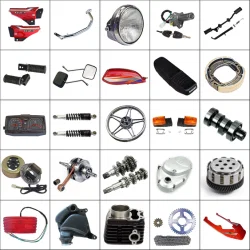List of some essential motorcycle parts
2023-11-24
Motorcycles are complex machines composed of various parts that work together to ensure proper functioning and performance. Here is a list of some essential motorcycle parts:
1. Frame: The frame is the structural foundation of the motorcycle, providing support for all other components.
2. Engine: The engine is the heart of the motorcycle, converting fuel into mechanical energy to propel the bike.
3. Transmission: The transmission system transfers power from the engine to the wheels, allowing the rider to control the speed of the motorcycle.
4. Wheels and Tires: These components provide traction and support for the motorcycle. Tires come in various types, such as sport, touring, cruiser, and off-road, depending on the bike's intended use.
5. Suspension System: The suspension system absorbs shocks and vibrations, providing a smoother ride and better handling. It includes components like forks and shock absorbers.
6. Brakes: Brakes are crucial for stopping the motorcycle. They typically consist of disc brakes, drum brakes, or a combination of both.
7. Exhaust System: The exhaust system manages the flow of exhaust gases from the engine. It often includes components like the exhaust pipe, muffler, and catalytic converter.
8. Fuel System: The fuel system delivers fuel to the engine for combustion. It includes the fuel tank, fuel pump, carburetor or fuel injection system, and related components.
9. Electrical System: The electrical system powers lights, signals, the ignition system, and other electronic components. Key parts include the battery, alternator or generator, wiring, and switches.
10. Handlebars and Controls: These components allow the rider to steer the motorcycle and control various functions. This includes the handlebars, grips, throttle, brake levers, and switches.
11. Seat: The seat provides a comfortable and secure place for the rider and sometimes a passenger.
12. Lights and Indicators: Headlights, taillights, turn signals, and brake lights are essential for visibility and safety.
13. Chain or Belt Drive: Some motorcycles use a chain or belt to transfer power from the engine to the rear wheel.
14. Kickstand and Center Stand: These are used to support the motorcycle when it is parked.
15. Air Filter: The air filter ensures that only clean air enters the engine for combustion.
16. Oil Filter: The oil filter removes impurities from the engine oil, helping to keep the engine lubricated and running smoothly.
17. Cooling System: Liquid-cooled motorcycles have a radiator and coolant to regulate engine temperature.
18. Fairings and Fenders: Fairings are protective shells that cover parts of the motorcycle, improving aerodynamics and protecting the rider from wind and debris. Fenders help prevent water and debris from reaching the rider and other components.
Understanding these components is crucial for motorcycle maintenance, customization, and troubleshooting. It's essential to regularly inspect and maintain these parts to ensure the motorcycle's safety and optimal performance.



